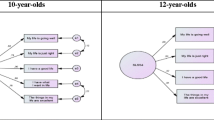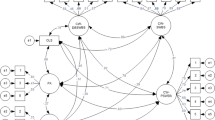Abstract
The potential to make cross-national comparisons is an important aspect of the growing global interest in subjective well-being. Such comparisons offer the prospect of understanding variations in levels of well-being and the factors contributing to it which can be useful for practical and policy initiatives to improve the lives of the population. However, relatively little is known about the extent to which such comparisons are reliable and valid, particularly in relation to children’s well-being. We make use of a large-scale pilot survey undertaken in 11 countries with over 16,000 children around the age of 12 to explore this issue. We examine four different multi-item measures of children’s subjective well-being, three of which have previously been proposed in the literature. We use multi-group confirmatory factor analysis to assess the extent to which it is valid to make cross-national comparisons using these measures. Overall, our results suggest that it should be possible to compare correlations and regressions between most of the countries in our survey using each of these measures. However, cross-national comparisons of mean scores on the measures is generally not supported by our analysis.




Similar content being viewed by others
References
Adamson, P. (Ed.) (2007). Child poverty in perspective: an overview of child well-being in rich countries. Report Card 7. Innocenti Research Centre. UNICEF.
Angelini, V., Cavapozzi, D., Corazzini, L., & Paccagnella, O. (2013). Do Danes and Italians rate life satisfaction in the same way? Using vignettes to correct for individual-specific scale biases. Oxford Bulletin of Economics and Statistics. doi:10.1111/obes.12039.
Arbuckle, J. L. (2010). IBM SPSS Amos 19 User’s Guide. Chicago: Amos Development Corporation.
Batista-Foguet, J. M., & Coenders, G. (2000). Modelos de Ecuaciones Estructurales. Madrid: La Muralla; Hespérides [ISBN: 84-7133-694-4].
Boehm, J. K., Lyubomirsky, S., & Sheldon, K. M. (2011). A longitudinal experimental study comparing the effectiveness of happiness-enhancing strategies in Anglo Americans and Asian americans. Cognition and Emotion, 25(7), 1263–1272. doi:10.1080/02699931.2010.541227.
Bolle, F., & Kemp, S. (2009). Can we compare life satisfaction between nationalities? Evaluating actual and imagined situations. Social Indicators Research, 90(3), 397–408. doi:10.1007/s11205-008-9265-0.
Bradshaw, J., Martorano, L., Natali, L., & de Neubourg, C. (2013). Children’s Subjective Well-being in Rich Countries, Working Paper 2013–03. UNICEF Office of Research, Florence. Retrieved from http://www.unicef-irc.org/publications/pdf/iwp_2013_3.pdf.
Browne, M. W., & Cudeck, R. (1993). Alternative ways of estimating model fit. In K. A. Bollen & J. S. Long (Eds.), Testing Structural Equation Models. Newbury Park: Sage Publications.
Byrne, B. M. (2010). Structural equation modelling with AMOS: Basic concepts, applications and programming (2nd ed.). New York: Routledge.
Casas, F., Sarriera, J. C., Abs, D., Coenders, G., Alfaro, J., Saforcada, E., & Tonon, G. (2011). Subjective indicators of personal well-being among adolescents. Performance and results for different scales in Latin-language speaking countries: a contribution to the international debate. Child Indicators Research, 5(1), 1–28. doi:10.1007/s12187-011-9119-1.
Casas, F., Tiliouine, H., & Figuer, C. (2013). The subjective well-being of adolescents from two different cultures: applying three versions of the PWI in Algeria and Spain. Social Indicators Research. doi:10.1007/s11205-012-0229-z.
Casas, F., Baltatescu, S., González, M., & Hatos, A. (2009). Similarities and differences in the PWI of Romanian and Spanish adolescents aged 13–16 years-old. Conference presentation. International Society for Quality of Life Studies. Florence, July 19–23.
Chen, F. F. (2007). Sensitivity of goodness of Fit indexes to lack of measurement invariance. Structural Equation Modeling: A Multidisciplinary Journal, 14(3), 464–504. doi:10.1080/10705510701301834.
Cheung, G. W., & Rensvold, R. B. (2002). Evaluating goodness-of-Fit indexes for testing measurement invariance. Structural Equation Modeling: A Multidisciplinary Journal, 9(2), 233–255. doi:10.1207/S15328007SEM0902_5.
Chong, W. C., Osman, M. M. B., Tong, E. M. W., & Tan, D. (2011). Self-construal and subjective well-being in two ethnic communities in Singapore. Psychology, 2(2), 67–70.
Coenders, G., Batista-Foguet, J. M., & Saris, W. (2005). Temas avanzados en modelos de ecuaciones estructurales. Madrid: La Muralla.
Cummins, R. A., & Lau, A. L. (2005). Personal wellbeing index—School children. Manual (3rd ed.). Melbourne: School of Psychology, Deakin University.
Cummins, R. A., Eckersley, R., Pallant, J., van Vugt, J., & Misajon, R. (2003). Developing a national index of subjective wellbeing: the Australian unity wellbeing index. Social Indicators Research, 64(2), 159–190. doi:10.1023/A:1024704320683.
Heller, D., Watson, D., & Ilies, R. (2004). The role of person versus situation in life satisfaction: a critical examination. Psychological Bulletin, 130(4), 574–600. doi:10.1037/0033-2909.130.4.574.
Helliwell J, Layard R, & Sachs J. (2012). World Happiness Report. The Earth Institute / CIFAR / CEP.
Hommerich, C., & Klient, S. (2012). Happiness: Does culture matter? International Journal of Well-Being, 2(4), 292–298.
Huebner, E. S. (1991). Initial development of the Student’s life satisfaction scale. School Psychology International, 12(3), 231–240. doi:10.1177/0143034391123010.
Huebner, E. S., Seligson, J. L., Valois, R. F., & Suldo, S. M. (2006). A review of the brief multidimensional students’ life satisfaction scale. Social Indicators Research, 79, 477–484.
Huebner, E. S., Antaramian, S. P., Hills, K. J., Lewis, A. D., & Saha, R. (2011). Stability and predictive validity of the brief multidimensional Students’ life satisfaction scale. Child Indicators Research, 4(1), 161–168. doi:10.1007/s12187-010-9082-2.
Huebner, E.S. & Hills, K.J. (2013) ‘Assessment of subjective well-being in adolescents’. In D. H. Saklofske, C. R. Reynolds, & V. L. Schwean (eds.). The Oxford Handbook of Child Psychological Assessment. Oxford University Press.
Kapteyn, A., Smith, J.P., & van Soest, A. (2009) Comparing Life Satisfaction (RAND Working Paper No. WR-623-1). Available at SSRN: http://ssrn.com/abstract=1289423 or doi:10.2139/ssrn.1289423.
Kim, H., Schimmack, U., & Oishi, S. (2012). Cultural differences in self- and other-evaluations and well-being: a study of European and Asian Canadians. Journal of Personality and Social Psychology, 102(4), 856–873. doi:10.1037/a0026803.
Kwan, Y., & Ip, W. (2009). Life satisfaction, perceived health, violent and altruistic behaviour of Hong Kong Chinese adolescents: only children versus children with siblings. Child Indicators Research, 2(4), 375–389. doi:10.1007/s12187-009-9041-y.
Marques, S. C., Lopez, S. J., & Pais-Ribeiro, J. L. (2011). “Building hope for the future”: a program to foster strengths in middle-school students. Journal of Happiness Studies, 12(1), 139–152. doi:10.1007/s10902-009-9180-3.
Marsh, H. W., Lüdtke, O., Muthén, B., Asparouhov, T., Morin, A. J. S., Trautwein, U., & Nagengast, B. (2010). A new look at the big five factor structure through exploratory structural equation modeling. Psychological Assessment, 22(3), 471–491.
Meredith, W. (1993). Measurement invariance, factor analysis and factorial invariance. Psychometrika, 58, 525–543.
Park, N., & Huebner, E. S. (2005). A cross-cultural study of the levels and correlates of life satisfaction among adolescents. Journal of Cross-Cultural Psychology, 36(4), 444–456. doi:10.1177/0022022105275961.
Seligson, J. L., Huebner, E. S., & Valois, R. F. (2003). Preliminary validation of the Brief Multidimensional Students’ Life Satisfaction Scale (BMSLSS). Social Indicators Research, 61(2), 121–145. doi:10.1023/A:1021326822957.
Siyez, D. M., & Kaya, A. (2008). Validity and reliability of the Brief Multidimensional Students’ Life Satisfaction Scale with Turkish children. Journal of Psychoeducational Assessment, 26(2), 139–147. doi:10.1177/0734282907307802.
Tomyn, A. J., & Cummins, R. A. (2011). The subjective wellbeing of high-school students: validating the personal wellbeing index—school children. Social Indicators Research, 101(3), 405–418. doi:10.1007/s11205-010-9668-6.
Tov, W., & Diener, E. (2007). Culture and subjective well-being. In S. Kitayama & E. Cohen (Eds.), Handbook of Cultural Psychology (pp. 691–713). New York: Guilford.
Uchida, Y., Norasakkunkit, V., & Kitayama, S. (2004). Cultural constructions of happiness: theory and emprical evidence. Journal of Happiness Studies, 5(3), 223–239. doi:10.1007/s10902-004-8785-9.
Veenhoven, R. (2009). Comparability of happiness across nations. Journal of Happiness Studies: An Interdisciplinary Forum on Subjective Well-being, 211–234.
Vittersø, J., Biswas-Diener, R., & Diener, E. (2005). The divergent meanings of life satisfaction: item response modeling of the satisfaction with life scale in Greenland and Norway. Social Indicators Research, 74(2), 327–348. doi:10.1007/s11205-004-4644-7.
Author information
Authors and Affiliations
Corresponding author
Rights and permissions
About this article
Cite this article
Casas, F., Rees, G. Measures of Children’s Subjective Well-Being: Analysis of the Potential for Cross-National Comparisons. Child Ind Res 8, 49–69 (2015). https://doi.org/10.1007/s12187-014-9293-z
Accepted:
Published:
Issue Date:
DOI: https://doi.org/10.1007/s12187-014-9293-z




